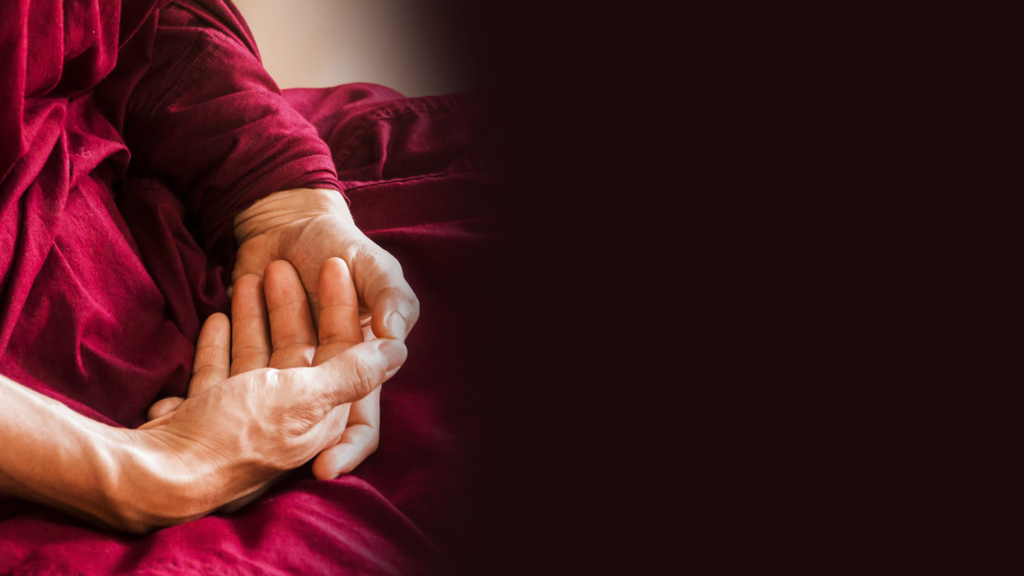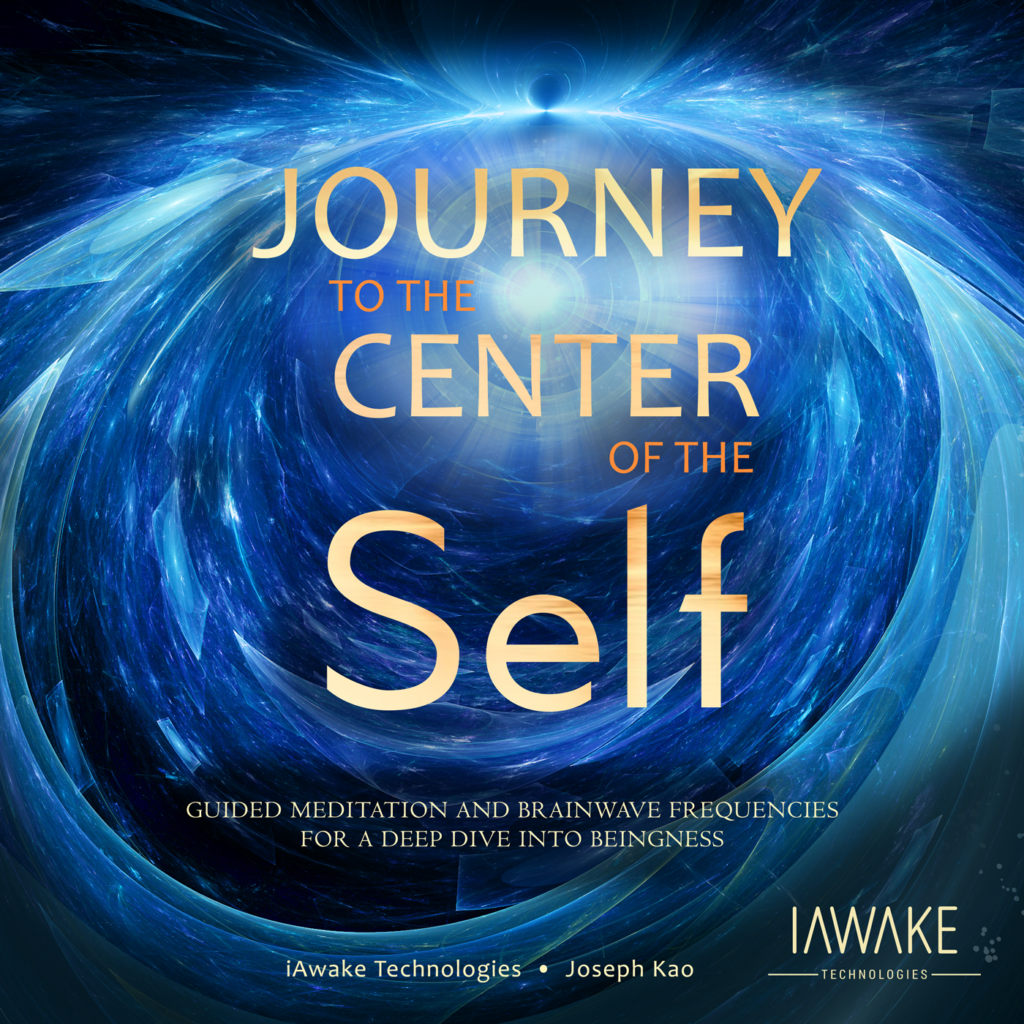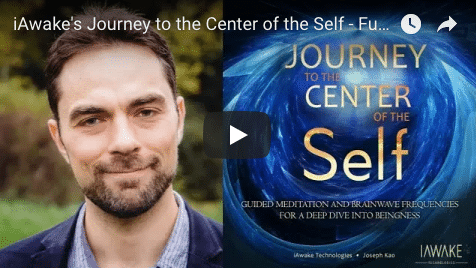A Guide to Transpersonal Meditation: Journey to the Center of the Self
Joseph Kao, creator of Journey to the Center of the Self, a deep, 30-minute, guided transpersonal meditation, accompanied by music embedded with advanced brainwave entrainment technology and followed by 30 minutes of only the brainwave entrainment music, talks with iAwake’s CEO, John Dupuy, about all that went into the making of this meditation tool masterpiece.
Transcending and Including the Little Self
 John: One thing I find so remarkable about your guided meditation in Journey to the Center of the Self, Joe, is you’re always bringing the personal along with the transcending. I use Ken Wilber’s Integral Theory a lot, and we talk about how when we transcend something, we also have to include—transcend and include. So when we go into Big Self, we don’t say, “Bye, little self!I’m just spaciousness, emptiness, consciousness, God, spirit…” I don’t know if you had some prior ideas about this, or if you created this all fresh for Journey, but it’s brilliant!
John: One thing I find so remarkable about your guided meditation in Journey to the Center of the Self, Joe, is you’re always bringing the personal along with the transcending. I use Ken Wilber’s Integral Theory a lot, and we talk about how when we transcend something, we also have to include—transcend and include. So when we go into Big Self, we don’t say, “Bye, little self!I’m just spaciousness, emptiness, consciousness, God, spirit…” I don’t know if you had some prior ideas about this, or if you created this all fresh for Journey, but it’s brilliant!
Joe: Well, I’ve been working as a hypnotherapist and psychotherapist since 2005, and I’ve worked with a lot of people on a large variety of therapeutic issues. So, I’ve had a lot of experience guiding people through group meditations—also through inner work, to heal and transcend and include whatever particular issues. The way people relate to their own experience is something that’s become more and more apparent to me as a key part of healing, and a key part of spiritual development, where instead of saying, “I don’t want to feel this,” “I don’t want to have that,” “I want to have this instead,” you learn to relate with both including and transcending your experience.
I mention this because when you said to me, all those months ago, “Joe, why don’t you create a product with just a deep, deep dive into beingness? What do you think about the title Journey to the Center of the Self?” I thought, okay, there’s a challenge here… to rise to the challenge of creating something that lives up to that name.
It’s not that it all came in a flash, in an epiphany, “Aha! This is what the meditation is going to be.” It was a process of drawing from and distilling down the principles I’ve used in my own personal practice over the years, and the principles I’ve used to guide other people through healing work and through guided meditations, and putting it all into a half-hour process, or what could be a full-hour process if you listen to both tracks.
One way of thinking about what a guided meditation is, it’s a training, and using certain principles as you meditate. There are some key principles that Journey to the Center of the Self trains you in, principles that will pretty much universally be of help on your journey. How you relate to your own experience and bringing loving-kindness towards your own experience is a foundational principle. These principles don’t instantly transport you to a full awakening—there’s work to be done, there’s your own path to follow. But there’s a way of internalizing these principles, of taking yourself through the process, until more and more they become second nature to you, so when you sit down to meditate, they’re just part of how you relate to yourself, how you relate to your own experience.
John: Exactly. And the more you use it, the deeper you’ll get. You’re really teaching people how to do a deep, spiritual, transpersonal meditation—how to get into that space that everyone is always talking about and writing about.
3 Key Principles Entrained in Journey Listeners
Joe: Just for the sake of this conversation, let’s say there are three core principles Journey will entrain you in. They’re not listed on the track because it’s not point 1, point 2, point 3, but these are three fundamental themes that come through.
1. Bring clarity into deep relaxation.
 Take yourself into a profound state of relaxation, where the body comes to rest and the conceptual mind, the grasping mind, naturally settles down, so that any sense of trying to grasp onto “this means this” or “I must be experiencing this now” or “is this it?”… all of that calms down and quiets down. At the same time, rather than drifting off into a daydream, bring clarity into that—bring clarity into deep relaxation. That’s a fundamental principle I have found to be very helpful in doing any work on myself.
Take yourself into a profound state of relaxation, where the body comes to rest and the conceptual mind, the grasping mind, naturally settles down, so that any sense of trying to grasp onto “this means this” or “I must be experiencing this now” or “is this it?”… all of that calms down and quiets down. At the same time, rather than drifting off into a daydream, bring clarity into that—bring clarity into deep relaxation. That’s a fundamental principle I have found to be very helpful in doing any work on myself.
2. Relate to your experience with loving-kindness, with acceptance.
This has done such a lot for me. People sometimes find it hard to immediately bring loving-kindness towards themselves. You can begin by bringing it to your hands, to your feet, by identifying any sense of resistance to loving-kindness. There’s a part of you that may say, “Well, I’m not sure it’s okay to feel warm and loving and accepting towards myself and my experience.” You can bring loving-kindness towards that, too. This can become like shadow work as well.
John: Yes, this is essential for shadow work, because if you’re going to the dark, unconscious places where all the dragons and scary stuff live, you have to be able to relax and approach it with loving-kindness. If you’re judgmental, it will stay cut off. So, being able to cultivate this practice is essential for any psychological or deep spiritual work.
Joe: Absolutely. Maybe there’s more to these three things than I thought, more than a mnemonic to help us remember to do all of this, because for a long time I’ve worked with the three dantians in Taoist meditation as a foundation for my own practice. You have the lower dantian of centering yourself in the core of your body, which links to that profound relaxation I was talking about, of quieting everything down, and sinking and centering yourself in one point, being present and grounded.
Then, there’s working with the heart, bringing loving-kindness to your own experience, breathing loving-kindness in and out through the chest and doing heart-based work.
And then there’s the third thing, which is what Journey to the Center of the Self focuses on for a substantial amount of the track:
3. Working with the void, working with space, working with pure consciousness.
There’s an English mystic and philosopher, Douglas Harding, who wrote a very famous book On Having No Head. It’s a series of experiments on consciousness. From your subjective experience, you are a porthole. Where your head is, your subjective experience of reality right now is a hole.
John: I’m a hole!
Joe: (Laughs) There’s a body, there’s a torso coming out from underneath it, there are legs, and there are arms you can see to the side. Your subjective experience is really just this window through which you experience the whole of your life.
This is something I came across years ago, but it always stuck with me. It has created mini-awakenings for me, mini-epiphanies, and is something I’ve brought into my own inner practice: becoming aware of endless space… language starts to run out here. We’re talking about the Tao, the Big Mind.
Another practice that has helped me a lot over the years are the Open Focus techniques, developed by neurofeedback researcher Les Fehmi, Ph.D. It’s about getting out of Narrow Focus (“Now I’m attending to this… Now I’m attending to this…”) and broadening out, noticing the space between your fingers, the space between your thoughts, the space out of which thoughts arise and into which they dissolve. This brings you back to the great nameless, the place where language can only point to, but cannot conceptualize. What is often called the Tao, the Big Mind.
Journey to the Center of the Self
The Journey recording takes all I know from my own spiritual practice and from guiding people in meditations. It’s steering people towards that and saying, “Here. Here. But stay true to your experience. It’s not the words I’m saying. It’s your experience.” We’re using the journey as a metaphor, but the journey is right back to here, because it’s always here. It’s always coming right back to your experience here and now, and not lusting after altered states, not lusting after flashes of blinding illumination. It’s always here, and it’s always now.
 John: In Journey, there’s a definite transmission of that state. Not just pointing a finger, but it’s the moon, too. When you get into non-duality, what comes through is like you’re really there. Personally, by the time I’ve finished the first half hour, I’m just there.
John: In Journey, there’s a definite transmission of that state. Not just pointing a finger, but it’s the moon, too. When you get into non-duality, what comes through is like you’re really there. Personally, by the time I’ve finished the first half hour, I’m just there.
In some ways, the state you’re talking about is the goal of meditation. But it’s also the ground, the starting place of real meditation. Because once we can identify with awareness, that pure consciousness in which all arises moment to moment, then our transformation really speeds up, whether we’re dealing with shadow issues or soul-centric issues, like “What am I here to do as an individual human being?” So, all of this stuff can begin, but you have to get there first.
The brainwave entrainment added to this inductive, guided, very compassionate, very wise meditation with your beautiful voice and the music is extraordinary! I’ve really never experienced anything else like it.
Giving Yourself Permission to Be Human
Joe: That’s amazing to hear, John. I wanted to add one thing to what I was just saying, going back to heart-based work. Let’s say you’ve reached a place of acceptance, of accepting something that for a long time you’ve been pushing away, that you’ve been resisting, and then comes this beautiful softening, dissolving, opening… it can be very moving. I’m British, but tears have sometimes come down.
John: (Laughs)
Joe: My point is the mind can be tricksy and can lead you to wanting to grasp onto that feeling, of wanting to recreate it, and then direct experience becomes merely a conceptual representation like, “I must preserve that,” or “Next time I do that meditation, I must get that back.”
John: Yes, it’s natural to want to recreate blissful states of oneness. But as you’re saying, it can become something to get hung up on and stop your forward progress. So you have to learn to appreciate the self appreciating it without trying to grasp it. To just stay in that openness, in that spaciousness.
Joe: Within heart-based work, you can do that in very small-chunk ways. If there’s a little bit of resistance, or a little bit of skepticism, or a little bit of grasping, you include those in the welcoming and realize that’s the human skeptical part of the mind, and it’s bull. With the welcoming, you give yourself permission to be human and accept all these different human traits within yourself.
The same thing is true when you go into a much more expanded sense of self—when you go into what we sometimes call Big Mind, the non-dual state, or whatever you want to call it, identifying as the Tao, as the big flow. Here, there is still the same tricksy-ness of the mind at work, however long afterwards or even in the midst of it, that can start to conceptualize: “Oh wow, I feel like a big sphere that encompasses the whole universe.” This is your mind’s way of representing something that goes beyond representations, but still, the representational aspect of the mind is trying to make sense of things.
Going Beyond Conceptualization
 So within Journey to the Center of the Self, I wanted to work with that. Because it’s not just about going into the void, into the Tao, into that-which-cannot-be-named. It’s also about noticing how you are representing yourself when you do that. Then, what’s beyond that representation, what’s beyond? It’s acknowledging the slight tricksy-ness of the conceptual mind and allowing for that… allowing for that to be human and then noticing what’s beyond those representations, noticing the space out of which they arise and into which they dissolve.
So within Journey to the Center of the Self, I wanted to work with that. Because it’s not just about going into the void, into the Tao, into that-which-cannot-be-named. It’s also about noticing how you are representing yourself when you do that. Then, what’s beyond that representation, what’s beyond? It’s acknowledging the slight tricksy-ness of the conceptual mind and allowing for that… allowing for that to be human and then noticing what’s beyond those representations, noticing the space out of which they arise and into which they dissolve.
I’ve certainly found this very valuable over the years for myself. It’s having that ability to clock, “Okay, that’s a conceptualization. That’s a representation. What’s beneath that? What’s beyond that?” And sinking into that and doing it with gentle persistence. Right back to mindfulness 101.
John: Also, non-dually get to the point where, “Oh, my mind conceptualizing is also the Tao.” Getting to the point where, “Hey, whatever it is, maybe I’m thinking about football, this is like the Tao being distracted from meditation and thinking about the football game that’s going to happen this weekend. At a certain point, we have to differentiate it, then we bring it back, and it’s all the “it” or “what is” and thou art that, right?
Joe: (Laughs)
John: Joe, this could be a whole meditation course, and I’m so glad people are getting to feel the quality of your spirit and your soul and your mind, knowing they’ll be going on this journey with you.
Joe: Some of the things I’m saying to you right now, John, are things that I’ve never said before. Being extensively trained in Ericksonian Hypnotherapy and having taught classes in different countries, there’s a lot about which I can speak very clearly and eloquently (I like to think, anyway) about how hypnotherapy works, about how Brief Therapy works, and about guided meditations. But I’m not a lecturer on the spiritual path. This is my own personal experience that I’m attempting to articulate here.
I can guide people through processes, but actually describing what is nameless, my mind trips up a bit—and I think that’s okay. Because if you’re overly confidently describing exactly how spiritual states are, those concepts are probably things to hold lightly in and of themselves, because there does come a point when what we’re talking about is formlessness, and formlessness as a word is just a word, but the experience of what we’re talking about goes beyond words. Arguably, we can sit here in silence.
John: It’s wonderful, Joe, because you’re a very eloquent speaker, and here you’re also bringing spontaneity based on many years of your own experience, since you haven’t talked about it a lot. So, there’s beginner’s mind, and it’s charming. You’re not giving prepared, clichéd speeches that you deliver all over the place—you’re creating it as we’re having this conversation.
I’m so glad we’ve had this interview, so that everybody can sense into this. I think the more you know about the creation of a product and what goes into it, the more appreciation there is. It’s like the Sgt. Pepper album—you listen to it and it’s fantastic music. But then you get into what was going on behind the scenes, and the ability to appreciate it in context—what it is and how it was birthed into the world—becomes infinitely deeper. Joe, you did a brilliant job with this, and I really appreciate it.
To read a fascinating account of all that went into creating the multi-level brainwave entrainment technology and music in the recording of this remarkable new transpersonal meditation tool, see part II, What is Advanced Brainwave Entrainment, Anyway? which is the second half of this interview with Joseph Kao.
Listen to the full Guide to Transpersonal Meditation interview with Joseph Kao on YouTube here:
Journey to the Center of the Self will be released by iAwake Technologies on September 13, 2018.
___________________________________________
 Joseph Kao, creator of Profound Releasing, Profound Renewal, and Sound Asleep, is a hypnotherapist and a solution-focused therapist with a private practice in Cambridge, UK. Joe was the co-developer of an acclaimed course on conversational hypnosis, and he regularly teaches hypnotherapy and psychotherapy to other therapists. He has also been the head scriptwriter for over 800 professional hypnotherapy recordings. Joe was drawn to the world of philosophy, meditation, and brainwave entrainment technology from an early age, and he’s had a daily meditation practice since 1998.
Joseph Kao, creator of Profound Releasing, Profound Renewal, and Sound Asleep, is a hypnotherapist and a solution-focused therapist with a private practice in Cambridge, UK. Joe was the co-developer of an acclaimed course on conversational hypnosis, and he regularly teaches hypnotherapy and psychotherapy to other therapists. He has also been the head scriptwriter for over 800 professional hypnotherapy recordings. Joe was drawn to the world of philosophy, meditation, and brainwave entrainment technology from an early age, and he’s had a daily meditation practice since 1998.
___________________________________________

John Dupuy is the CEO of iAwake Technologies and travels internationally to teach and inspire on the subjects of Integral Recovery, Integral Transformative Practice, and the use of brainwave entrainment technology to deepen one’s meditation practice and in the treatment of addiction, depression, and PTSD. John is the founder of Integral Recovery® and his book Integral Recovery: A Revolutionary Approach to the Treatment of Alcoholism and Addiction won the 2013 USA Best Book Award. John also hosts interviews with leading innovators in the spiritual technologies field on Spiritual Technologies 2.0 Live and co-hosts the popular Journey of Integral Recovery podcast.
___________________________________________
 This blog was created from an interview with Joseph Kao, creator of iAwake’s Journey to the Center of the Self, and iAwake’s CEO John Dupuy, by Heidi Mitchell, who has been working with John for 11 years as assistant and editor. John introduced her to Integral theory and practice and brainwave entrainment enhanced meditation in 2007. Heidi is also a freelance editor of nonfiction books, blogs, and web sites. She can be reached at www.heidimitchelleditor.com.
This blog was created from an interview with Joseph Kao, creator of iAwake’s Journey to the Center of the Self, and iAwake’s CEO John Dupuy, by Heidi Mitchell, who has been working with John for 11 years as assistant and editor. John introduced her to Integral theory and practice and brainwave entrainment enhanced meditation in 2007. Heidi is also a freelance editor of nonfiction books, blogs, and web sites. She can be reached at www.heidimitchelleditor.com.
Leave your comments below
1 Comments
Leave a Comment
You must be logged in to post a comment.



[…] all that went into the making of the inductive guided meditation on the first track of Journey, see A Guide to Transpersonal Meditation: Journey to the Center of the Self, part I of this […]